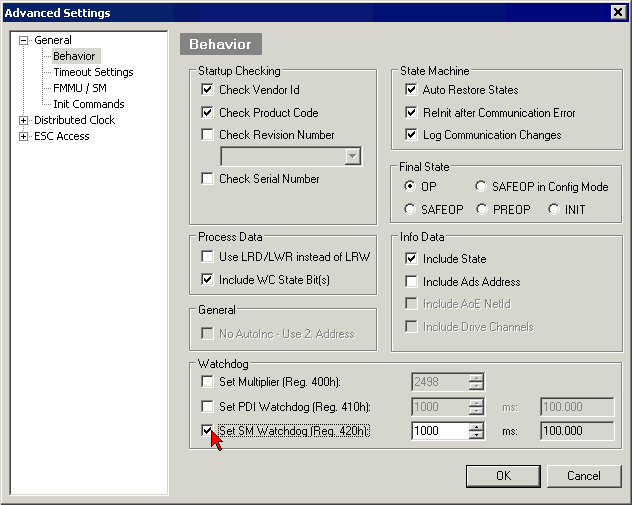General notes for setting the watchdog
The EtherCAT terminals are equipped with a safety device (watchdog) which, e. g. in the event of interrupted process data traffic, switches the outputs (if present) to a presettable state after a presettable time, depending on the device and setting, e. g. to FALSE (off) or an output value.
The EtherCAT slave controller (ESC) features two watchdogs:
- SM watchdog (default: 100 ms)
- PDI watchdog (default: 100 ms)
Their times are individually parameterized in TwinCAT as follows:

Notes:
- the Multiplier Register 400h (hexadecimal, i. e. x0400) is valid for both watchdogs.
- each watchdog has its own timer setting 410h or 420h, which together with the Multiplier results in a resulting time.
- important: the Multiplier/Timer setting is only loaded into the slave at EtherCAT startup if the checkbox in front of it is activated.
- if it is not checked, nothing is downloaded and the setting located in the ESC remains unchanged.
- the downloaded values can be seen in the ESC registers x0400/0410/0420: ESC Access -> Memory
SM watchdog (SyncManager Watchdog)
The SyncManager watchdog is reset with each successful EtherCAT process data communication with the terminal. If, for example, no EtherCAT process data communication with the terminal takes place for longer than the set and activated SM watchdog time due to a line interruption, the watchdog is triggered. The status of the terminal (usually OP) remains unaffected. The watchdog is only reset again by a successful EtherCAT process data access.
The SyncManager watchdog is therefore a monitoring for correct and timely process data communication with the ESC from the EtherCAT side.
The maximum possible watchdog time depends on the device. For example, for "simple" EtherCAT slaves (without firmware) with watchdog execution in the ESC it is usually up to 170 seconds. For complex EtherCAT slaves (with firmware) the SM watchdog function is usually parameterized via Reg. 400/420 but executed by the µC and can be significantly lower. In addition, the execution may then be subject to a certain time uncertainty. Since the TwinCAT dialog may allow inputs up to 65535, a test of the desired watchdog time is recommended.
PDI watchdog (Process Data Watchdog)
If there is no PDI communication with the EtherCAT slave controller (ESC) for longer than the set and activated PDI watchdog time, this watchdog is triggered.
PDI (Process Data Interface) is the internal interface of the ESC, e.g. to local processors in the EtherCAT slave. With the PDI watchdog this communication can be monitored for failure.
The PDI watchdog is therefore a monitoring for correct and timely process data communication with the ESC, but viewed from the application side.
Calculation
Watchdog time = [1/25 MHz * (Watchdog multiplier + 2)] * PDI/SM watchdog
Example: default setting Multiplier=2498, SM watchdog=1000 -> 100 ms
The value in Multiplier + 2 corresponds to the number of 40ns base ticks representing one watchdog tick.
| |
Undefined state possible! The function for switching off the SM watchdog via SM watchdog = 0 is only implemented in terminals from version -0016. In previous versions this operating mode should not be used. |
| |
Damage of devices and undefined state possible! If the SM watchdog is activated and a value of 0 is entered the watchdog switches off completely. This is the deactivation of the watchdog! Set outputs are NOT set in a safe state if the communication is interrupted. |
